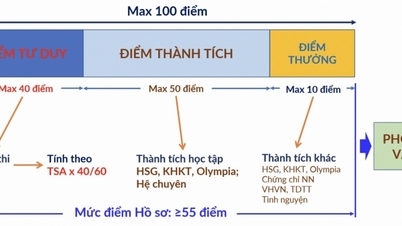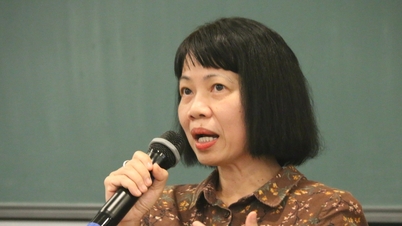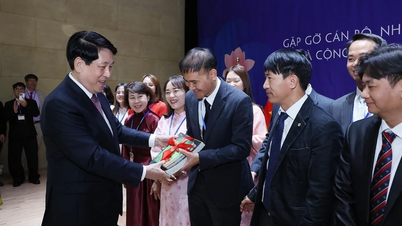The Ministry of Education and Training has just introduced a draft circular amending and supplementing a number of articles of the Regulations on university and college admissions for Preschool Education.
 |
| Associate Professor, Dr. Nguyen Thu Thuy said that the draft circular amends and supplements a number of articles of the University Admissions Regulations. (Source: MOET) |
Associate Professor Dr. Nguyen Thu Thuy, Director of the Department of Higher Education (Ministry of Education and Training) spoke to the press about the expected new adjustments in the draft circular.
Can you share the core new points of this draft circular compared to the current admission regulations?
The draft revised circular focuses on overcoming shortcomings in current enrollment work.
Firstly, training institutions use many methods and subject combinations for admission to the same training program or major, including some training institutions allocating too many quotas for early admission, or setting too large bonus points for foreign language certificates.
Second, 2025 is the first year that students studying under the new general education program will be considered for university admission. Therefore, it is necessary to reform the admission regulations to meet the requirements of the innovations in the 2018 General Education Program, creating a positive impact on teaching and learning at the high school level.
Accordingly, the core new points include adjusting the regulations on the threshold to ensure input quality for the groups of pedagogical and health majors; early admission quotas are determined by training institutions but do not exceed 20% of the quota for each major and group of training majors; admission scores and passing scores of methods and subject combinations used for admission must be converted to a common, unified scale for each program, major, and group of training majors; admission based on academic records must use the candidates' entire 12th grade study results...
What is the basis for the Ministry of Education and Training to come up with the figure of 20%? What are the reasons that make you believe that these limits will overcome the current enrollment shortcomings?
The draft regulation requires equivalent conversion of the review score and admission score of the admission methods, along with the requirement that the early admission score is not lower than the admission score in the general admission round, automatically limiting the scale of early admission.
The 20% limit is based on the practical situation of enrollment in recent years, so that early enrollment only focuses on candidates with outstanding abilities and academic achievements, limiting the impact on students' studies in the final semester of grade 12 and high school graduation exam preparation. The most important thing is to create fairness among candidates when applying, not all students are able to participate in early enrollment before completing the grade 12 program.
Reducing the scale of early admission not only does not cause difficulties, but also creates more convenience for the admission work of schools and candidates.
Whether there is early admission or only general admission, the total number of candidates registered for admission does not change, so why do schools have to work hard to compete for early admission? Why do students who have not completed the 12th grade program have to work hard to submit applications to many places, and then not feel secure in studying, while the Ministry of Education and Training has a general admission support system with a complete database, a completely online process that is convenient for both candidates and schools.
It's time we look back at the early admission trend (popular in the past 5-6 years) objectively, to find fundamental solutions and completely resolve the shortcomings.
The requirement of the Ministry of Education and Training that the admission scores and passing scores of the methods and subject combinations used for admission must be converted to a common, unified scale for each training program, major, and group of majors is very new. Can you explain why this additional regulation is required?
In recent years, most training institutions have allocated separate quotas for each admission method, even for each admission subject group, from which they apply admission criteria to calculate the candidates' scores and determine the admission scores from high to low until the quota for each method and admission subject group is exhausted. This helps schools to use early admission to proactively complete their enrollment plans.
However, there is hardly any scientific or practical basis for allocating quotas between admission methods or combinations of subjects for a training program, leading to problems such as unreasonable differences in admission scores between methods and combinations of admission subjects, while pushing the benchmark score of the admission method based on high school graduation exam scores up very high because the quota for this method is not much left, especially in "hot" majors and schools. This causes unfair opportunities for candidates who do not have access to many admission methods.
Therefore, this draft revised regulation basically stipulates the unified application of equivalent conversion of admission scores of methods and subject combinations to a common, unified scale for each training program, industry, and group of industries, on that basis determining the admission score from high to low for all the quotas of the training program, industry, and group of industries, except for cases of direct admission and early admission of candidates with outstanding abilities and achievements.
The draft also stipulates that the conversion method must ensure the opportunity for all candidates to achieve the maximum score of the general scale and at the same time no candidate has a score exceeding this maximum score. Accordingly, training institutions will have to research to re-regulate the addition of points for foreign language certificates and other priority points, thereby limiting abuse that causes unfairness between candidates with different investment conditions for studying.
At that time, all candidates applying for a training program will be considered fairly based on a common score scale and a common admission standard, the chance of admission of candidates with real ability will increase and the quality of input of schools will also increase. Schools still have the opportunity to consider early admission to proactively compete to recruit the best candidates, at the same time, students with the best ability still have the opportunity to be admitted early to proactively decide to choose the most suitable learning path.
This regulation will limit early admission. In addition, there is a regulation that early admission is not allowed for more than 20% of the target. These will help to overcome the problems arising from early admission, as schools will not have to spend too much time and resources on this admission process, or many 12th grade students will neglect their studies when they know the admission results.
Is the regulation that admission based on transcripts must use the candidates' entire 12th grade academic results also aimed at tightening early admission, madam?
This is an additional measure to create a positive impact on teaching and learning in grade 12 while increasing the fairness and effectiveness of admissions. As the high school graduation exam is reformed, the ability to assess capacity and classification is improved, the results of this exam will certainly be used more.
The Ministry of Education and Training issued the above regulations to implement a basic principle in education, which is fairness, thereby improving the quality of enrollment and training, and absolutely does not create any barriers or have the purpose of forcing schools to use high school graduation exam scores for admission.
Source




![[Photo] Prime Minister Pham Minh Chinh chairs the second meeting of the Steering Committee on private economic development.](https://vphoto.vietnam.vn/thumb/1200x675/vietnam/resource/IMAGE/2025/11/01/1762006716873_dsc-9145-jpg.webp)











































































































Comment (0)